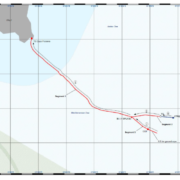Time to resume data taking in ARCA
15 September 2021 – after the recovery of two old detection units, already left disconnected after previous sea campaigns – the so-called PPM-DU (Pre-Production Model of Detection Unit), a 3-digital optical module unit used for qualification of the project in the sea as early as in 2014, and one of the first prototype full-size detection units deployed in spring 2016, the sea campaign of ARCA has been completed today.


